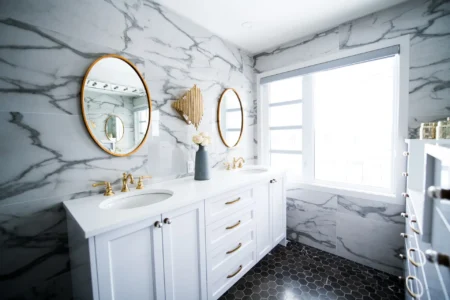Porcelain vs. ceramic tiles are often in contention when selecting the ideal tiles for your house or place of business. Both have their own qualities, appealing aesthetics, and useful uses. But which is superior? We’ll examine the variations between porcelain and ceramic tiles in this thorough guide, as well as dig into the realm of marble and other natural stone tiles. This article will provide information to assist you make a knowledgeable decision, whether you’re a homeowner wanting to remodel or a professional designer searching for the ideal material.
What’s the Difference Between Porcelain and Ceramic Tiles?
Although they are not the same, porcelain and ceramic tiles are often used interchangeably. Making the best decision for your unique requirements requires an understanding of the distinctions between these two kinds of tiles. Here are the main distinctions:
- Porcelain tiles are created from clay that has been cleansed and polished, making them denser and more durable. Conversely, ceramic tiles are softer and more porous. Their functionality and applicability are impacted by this basic difference.
- Durability: Porcelain tiles are renowned for their extraordinary toughness and resistance to damage. In comparison to ceramic tiles, they can sustain high foot traffic and are less prone to chipping and breaking. Porcelain could be the best choice if durability is your top goal.
- Water resistance: Porcelain tiles are notable for their low water absorption rate. They are thus suited for damp environments like bathrooms and kitchens. Although still water-resistant, ceramic tiles may not function as well under certain circumstances.
- Installation: While both kinds of tiles may be put in by experts or do-it-yourselfers, porcelain tiles need greater accuracy and skill. Due of their density, they are more difficult to cut and install, which might raise the cost and length of the installation process.
- Price: Porcelain tiles are often more costly than ceramic tiles. Their enhanced endurance and aesthetic appeal often make up for the higher price. However, clients on a tight budget could find ceramic tiles to be a more cost-effective choice.
These distinctions provide a place to start when figuring out what makes porcelain and ceramic tiles special. Understanding these variations can help you decide which option is ideal for your project, whether you value cost, durability, or both.
Comparing Designs and Finishes
Both porcelain and ceramic tiles provide a huge variety of styles and finishes when it comes to enhancing the aesthetic appeal of your room. Personal taste, the decor concept, and the desired mood are often the deciding factors when choosing between them. Let’s compare the beauty of these two varieties of tiles:
- Texture and sheen: Porcelain tiles are well-known for their gleaming, elegant sheen. They may replicate the look of genuine stone tiles, such as marble tiles, giving a space an opulent and sophisticated impression. On the other hand, ceramic tiles have a more natural look that is appropriate for situations that are relaxed and comfortable.
- Both porcelain and ceramic tiles are available in a wide range of hues, patterns, and styles. Both kinds of tiles may meet your demands, whether you’re going for a vivid mosaic or a sleek monochromatic design. Ceramic tiles may have a surface glaze, but porcelain tiles often have the color throughout the whole tile.
- Customization: Both porcelain and ceramic tiles have the ability to create one-of-a-kind, bespoke designs. The options are unlimited, ranging from complex designs to unique impressions. Your decision may be influenced by the particular design specifications and financial limitations.
- Porcelain tiles are noted for maintaining their look over time with little care needed. They continue to appear fresh for longer because to their resistance to stains and scratches. If they have a rough surface, ceramic tiles may need more frequent cleaning and upkeep to keep them looking nice.
- Environmental Considerations: It’s important to note that both porcelain and ceramic tiles may be environmentally beneficial choices for individuals who are concerned about sustainability. Many producers provide recycled-material tiles or use production techniques that are friendly to the environment. Your decision may be in line with your morals and dedication to sustainability.
Tile visual appeal is very individualized and mostly dependent on personal preferences and the overall design concept. Whether you choose the natural beauty of ceramic or the polished elegance of porcelain, being aware of their distinctive qualities will enable you to design a place that reflects your sense of style.
Popular Uses: Where to Utilize Porcelain and Ceramic Tiles
Porcelain and ceramic tiles have uses that go beyond simple beauty. They are appropriate for a variety of locations and uses thanks to their utilitarian qualities. Here’s a deeper look at some potential applications for these tiles:
- Bathrooms: Porcelain is a great material option for bathrooms because to its water resistance. Due to its limited porosity, mold and mildew cannot flourish because of moisture. Bathrooms may also employ ceramic tiles, but great consideration should be given to the glaze and finish.
- Kitchens: Porcelain and ceramic tiles are both preferred options for kitchen backsplashes and flooring. Ceramic has a broad variety of patterns, which allows for more creative freedom, while porcelain is appropriate for high-traffic areas because to its durability and simplicity of cleaning.
- Outdoor Spaces: Porcelain is a popular option for tiles in outdoor areas like patios and pool areas because of its resilience and resistance to weather. In severe weather, ceramic tiles may not function as effectively.
- business Spaces: Porcelain tiles often take the lead in business settings where upkeep and durability are crucial factors. They are appropriate for workplaces, retail establishments, and other public areas because of their ability to resist high foot traffic and preserve attractiveness.
- Ceramic tiles are often utilized for artistic and ornamental reasons because of their adaptability and simplicity of shape. Ceramic provides a blank canvas for creativity, from wall murals to embellishments that are hand-painted.
The distinction between ceramic and porcelain tiles goes beyond aesthetics. Selecting the ideal tiles for your unique demands and places will be aided by an understanding of their functional characteristics and widely used applications.
Conclusion
There is no clear, universal solution to the porcelain vs. ceramic tile dispute. Each sort of tile has its own distinct qualities, benefits, and uses. The decision between the natural appeal of ceramic and the polished beauty of porcelain often comes down to personal preferences, financial constraints, and particular project needs.
Porcelain tiles can be your best choice if you’re seeking for sturdiness, water resistance, and a luxurious finish. They are appropriate for both residential and commercial environments since they perform well in locations with high foot traffic and moisture exposure. Their visual appeal is enhanced by their capacity to replicate genuine stone tiles, particularly marble tiles.
On the other hand, ceramic tiles provide a more affordable solution without sacrificing design inventiveness or variation. Their adaptability makes them appropriate for creative efforts, and their extensive palette of hues and patterns may accommodate many design motifs.
Ultimately, whether you choose porcelain or ceramic tiles, knowing their distinctions and matching them to your requirements will guarantee a successful project. To select the greatest decision for your area, take into consideration speaking with a qualified designer or tile specialist. Always keep in mind that choosing the right tiles affects your space’s usefulness, comfort, and atmosphere as a whole.
FAQs
Which tile quality is best?
The “best” tile quality will vary depending on the particular requirements of your project. Because of its renowned toughness, water resistance, and exquisite surface, porcelain tiles are ideal for damp and high-traffic areas. Ceramic tiles are adaptable and come in a variety of patterns that work well for aesthetic and ornamental reasons. You may pick the highest quality by speaking with a tile professional about your needs.
Why is ceramic better than porcelain?
Because of its cheaper price, simplicity of installation, and extensive selection of colors and patterns, ceramic tiles may be seen as “better” than porcelain in certain circumstances. They are often chosen for adorning areas or projects when spending limits and creative freedom are important factors. Ceramic may be preferable in certain cases than other materials, however this relies on the particular requirements and preferences of the project.
Which is more expensive, ceramic tile or porcelain tile?
Porcelain tiles often cost more than ceramic tiles. The improved material composition, enhanced durability, and often more upscale look of porcelain are blamed for the higher price. Ceramic tiles are more cost-effective, but porcelain’s longer lifespan and aesthetic appeal may make up for its greater cost.
Should I use porcelain or ceramic tile in the kitchen?
You may use either porcelain or ceramic tiles in the kitchen; the best option is the one that best suits your demands and tastes. Kitchen floors and other high-traffic areas that are prone to spills and stains may benefit from porcelain’s longevity and low care requirements. The variety of colors and patterns available for ceramic tiles makes it a versatile material for use in backsplashes and other ornamental applications. Take into account the kitchen’s foot traffic, moisture level, and overall aesthetic while making your decision.




